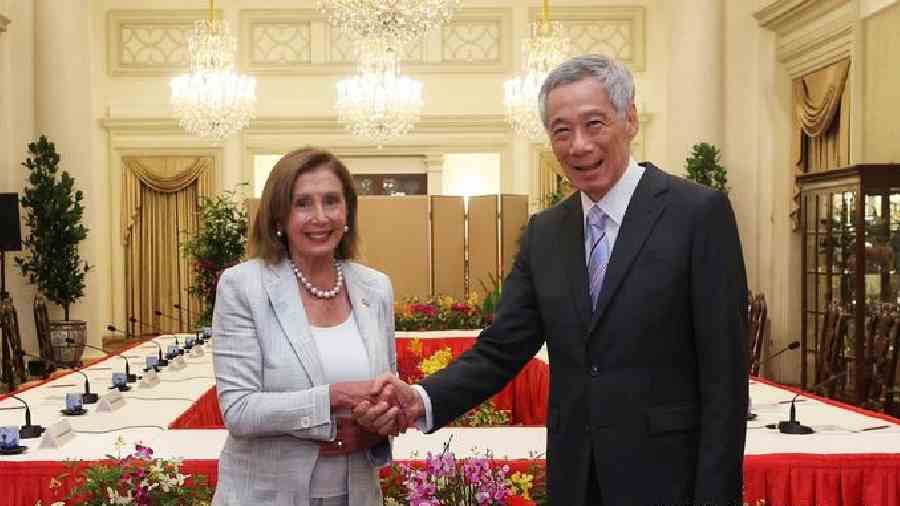Tensions between Beijing and Washington are rising over Taiwan, as United States House Speaker Nancy Pelosi may visit the self-governing island this week.
Pelosi, the highest US official after US President Joe Biden and Vice President Kamala Harris, has fiercely criticized China for decades, while ardently supporting Beijing's opposition including the Tiananmen Square protesters, Tibetan Buddhist leader the Dalai Lama, and Hong Kong pro-democracy activists.
The potential for a Taiwan visit during Pelosi's Asia tour, which kicked off on Saturday, has angered the Chinese authorities, who have recently ramped up their aggressive patrolling and overflights of Taiwan's air defense zone while conducting frequent military drills.
Pelosi has been vague about her plans to visit Taiwan but said last week it was "important for us to show support for Taiwan.”
Will the US defend Taiwan against China?
It is not clear to what extent Taiwan could rely on US support in case of Chinese aggression. For decades, Washington has maintained "strategic ambiguity" about Taiwan, officially known as the Republic of China (ROC), keeping up a friendly relationship with its government without formal diplomatic relations or even recognition as a fully sovereign state. The White House has been selling defensive military equipment to Taiwan; however, it has not officially committed itself to military intervention.
Meanwhile, China sees the island as its territory and has been developing plans to take it back, by force if necessary.
Over past decades, the Chinese Communist party has been preparing its military wing, known as The People's Liberation Army (PLA). The PLA dwarfs Taiwanese forces and, according to some experts, is more powerful than the forces any of Taiwan's supporters, such as the US or Japan, could afford to bring to the region.
But that doesn't mean Taipei is completely helpless against a possible PLA attack.
Porcupine strategy: A large number of small things
The potential risk of Chinese invasion has hung over Taiwan for decades, long enough for it to develop a sophisticated defense system suited to its geography.
To deal with a gigantic power like China, Taiwan has adopted an asymmetrical warfare method known as the "porcupine strategy," which aims to make the invasion very difficult and costly for the enemy.
Taiwan has stacked up large inventories of anti-air, anti-tank, and anti-ship weapons and ammunition. That includes unmanned aerial vehicles (UAVs) and low-cost munitions like mobile coastal defense cruise missiles (CDCMs), which have the capacity to destroy China's expensive naval vessels and naval equipment.
Stealth fast-attack crafts and miniature missile assault boats are other relatively cheap but highly effective equipment. They can be dispersed among fishing boats across Taiwan's ports. Sea mines and fast mine-laying ships could also complicate the landing operations of any invading navy.
A multilayered sea defense
To swiftly take the Island, China's PLA would need to transport many soldiers and great quantities of supplies — armored vehicles, weapons, ammunition, food, medical supplies and fuel — across the strait. This is only possible by sea, since airlifts and fleets of planes have limited capacity.
ROC's territory includes a chain of Islands, some of them near Chinese shores. Monitoring equipment installed on those islands can detect the first fleet departing from China's coasts. That is supposed to give the Taiwanese forces enough time to coordinate a multilayered defense.
Sea mines, combined with fast-attack craft and missile assault boats, along with land-based munitions positioned on shores and nearby islands, would face the PLA in its most vulnerable state, before it gets a chance to land and start an operation.
Guerrilla warfare
Taiwan has also prepared its cities for guerrilla warfare in case the PLA succeeds in getting boots on the ground. Man-portable air-defense systems (MANPADS) and mobile anti-armor weapons, such as high mobility artillery rocket systems (HIMARS), can be used in urban fights, while buildings can be turned into barracks.
According to a 2017 report published by the RAND foundation, there are 2.5 million men in the military reserve system plus 1 million civil defense volunteers. In total, that number accounts for about 15% of Taiwan's population and one man out of every four.
Defending the defense system
One of the main goals of Taiwan's tactics is to protect the principal defense systems, including aircraft and anti-ballistic defense systems, which can intercept ballistic rockets and inflict primary damage on invading powers.
In the last couple of years, Taiwan has purchased dozens of advanced fighter jets from the US, while manufacturing its own AIDC F-CK-1 Ching-Kuo, dubbed the Indigenous Defense Fighter. Many aircraft are being held in fortified bases, with the pilots being trained to use highways to land if airports are bombed.
In addition, even though Washington might not get involved if a conflict happens, it has vowed to continue selling defense systems and provide intelligence support to Taiwan.
All these measures would help Taiwan send a message to China that if a war breaks out, it would be lengthy, costly and bloody.
However, for a small defender like the ROC, the best scenario would be for the conflict to never happen.












